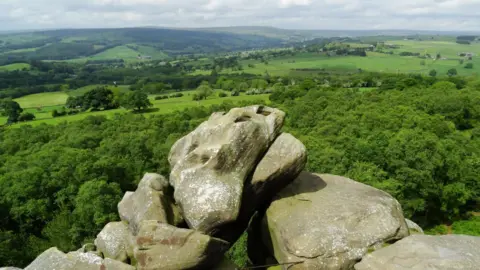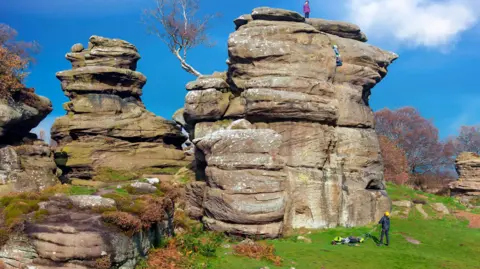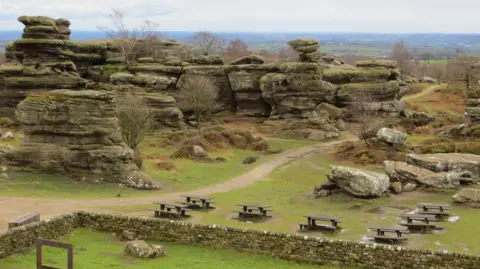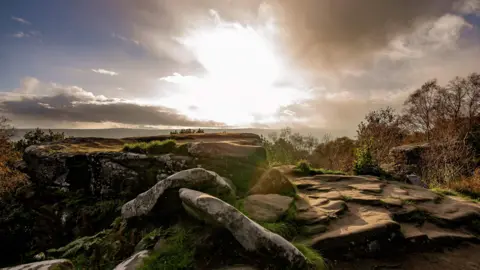The ancient rock formation that inspired romance
 Colin Park/Geograph
Colin Park/GeographFrom Romeo and Juliet to Cathy and Heathcliff, for many Valentine's Day sparks stories of star-crossed lovers.
One romantic Yorkshire landmark - silently shaped over 320 million years - has a sentimental tale of its own.
Lover's Leap, one of the many rock formations at Brimham Rocks, about 10 miles north-west of Harrogate, is home to the tale of Julia and Edwin - a pair whose unsanctioned romance was put to the ultimate test.
 Dark_Eni/Getty
Dark_Eni/GettyInitially formed when the North America and Eurasia tectonic plates collided deep in the Earth's past, the unusual beauty spot was shaped by millions of years of erosion.
The Ice Age saw wind, ice and rain gnaw away at softer rocks, leaving unusual shapes in the tougher millstone grit behind.
Those shapes garnered nicknames from visitors, including The Sphinx, The Dancing Bear and the Druid's Writing Desk.
Dr Stephen Lewis, a volunteer guide at the the National Trust-run site, has researched the stories behind the names of the rocks.
He says: "The first reference I can find to the rock called Lover's Leap is in a guidebook printed in 1863 by William Grange. He talks about the cliff as being three large crags and he calls it Lover's Leap.
"Grange described it as 'a leap from which would be likely to cure, not only the pangs of slighted love, but all the ills that flesh is heir to.'"
 Roy Valentine/Getty
Roy Valentine/GettyThe story behind Lover's Leap was not written about again until 1925, when a guidebook by a 'Mr Ogle' described the story of a couple called Julia and Edwin, says Dr Lewis.
"Julia and Edwin eloped and Julia's father wasn't happy and he chased after them on horseback with his labourers.
"Julia and Edwin found themselves at the top of the crag, Lover's Leap, and decided they would rather throw themselves off the cliffs and end their lives together than have her father separate them.
"So they threw themselves off the cliff and Brimham, being such a magical, mysterious place, the fairies that were living at the bottom of the cliff caught the pair and brought them safely down to ground.
"The father arriving at the top of the cliffs expecting to see his daughter dead, saw her alive and well and realised it would be better to allow the lovers to marry rather than to separate them."
 Jenni Shepherd/National Trust
Jenni Shepherd/National TrustAccording to Dr Lewis, visitors began coming to the site in the 1770s.
The first published record of a visit was Major Hayman Rooke – an antiquarian and soldier who wrote about archaeology.
Visitors continued coming to the site, and advertising material from the early railways shows druids, nymphs and fairies dancing around the rocks, says Dr Lewis.
In more recent years the rocks featured in the Bee Gees' anthemic 1987 number one hit You Win Again.
Director Leslie Libman, who shot the accompanying music video, took the band to the outcrop where they posed just a few yards from Lover's Leap.
Today Dr Lewis tells the story as part of his guided walks and says visitors usually greet the tale with a generous dollop of cynicism.
"Most people realise it is a legend conjured up by people in the past who have wanted to spread the word about Brimham.
"The site is a fascinating place."
Listen to highlights from North Yorkshire on BBC Sounds, catch up with the latest episode of Look North or tell us a story you think we should be covering here.
